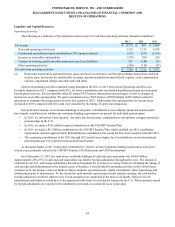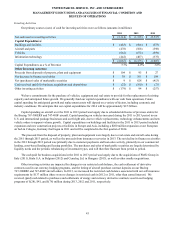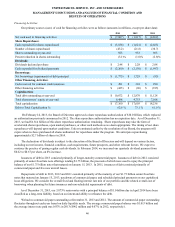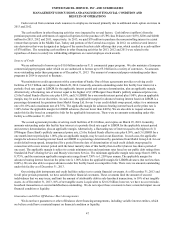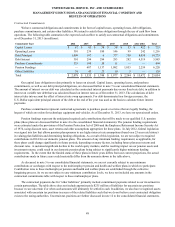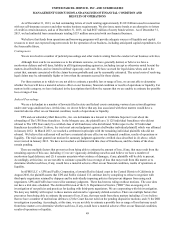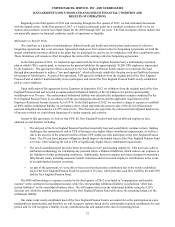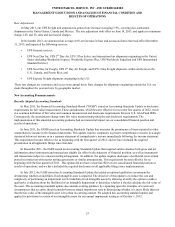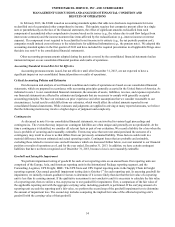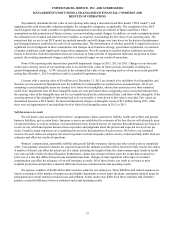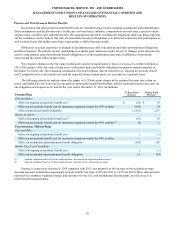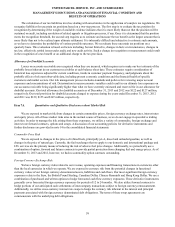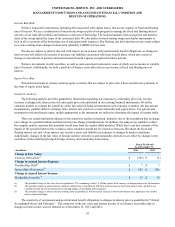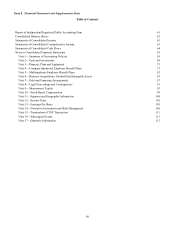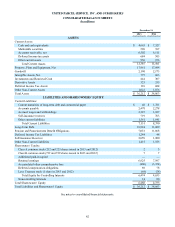UPS 2013 Annual Report Download - page 66
Download and view the complete annual report
Please find page 66 of the 2013 UPS annual report below. You can navigate through the pages in the report by either clicking on the pages listed below, or by using the keyword search tool below to find specific information within the annual report.UNITED PARCEL SERVICE, INC. AND SUBSIDIARIES
MANAGEMENT'S DISCUSSION AND ANALYSIS OF FINANCIAL CONDITION AND
RESULTS OF OPERATIONS
54
In February 2013, the FASB issued an accounting standards update that adds new disclosure requirements for items
reclassified out of accumulated other comprehensive income. This update requires that companies present either in a single
note or parenthetically on the face of the financial statements, the effect of significant amounts reclassified from each
component of accumulated other comprehensive income based on its source (e.g., the release due to cash flow hedges from
interest rate contracts) and the income statement line items affected by the reclassification (e.g., interest income or interest
expense). If a component is not required to be reclassified to net income in its entirety (e.g., the net periodic pension cost),
companies would instead cross reference to the related note for additional information (e.g., the pension note). We adopted this
accounting standard update in the first quarter of 2013 and have included the required presentation in all applicable filings since
that date (see note 9 to the consolidated financial statements).
Other accounting pronouncements adopted during the periods covered by the consolidated financial statements had an
immaterial impact on our consolidated financial position and results of operations.
Accounting Standards Issued But Not Yet Effective
Accounting pronouncements issued, but not effective until after December 31, 2013, are not expected to have a
significant impact on our consolidated financial position or results of operations.
Critical Accounting Policies and Estimates
Our discussion and analysis of our financial condition and results of operations are based on our consolidated financial
statements, which are prepared in accordance with accounting principles generally accepted in the United States of America. As
indicated in note 1 to our consolidated financial statements, the amounts of assets, liabilities, revenue, and expenses reported in
our financial statements are affected by estimates and judgments that are necessary to comply with generally accepted
accounting principles. We base our estimates on prior experience and other assumptions that we consider reasonable to our
circumstances. Actual results could differ from our estimates, which would affect the related amounts reported in our
consolidated financial statements. While estimates and judgments are applied in arriving at many reported amounts, we believe
that the following matters may involve a higher degree of judgment and complexity.
Contingencies
As discussed in note 8 to our consolidated financial statements, we are involved in various legal proceedings and
contingencies. The events that may impact our contingent liabilities are often unique and generally are not predictable. At the
time a contingency is identified, we consider all relevant facts as part of our evaluation. We record a liability for a loss when the
loss is probable of occurring and reasonably estimable. Events may arise that were not anticipated and the outcome of a
contingency may result in a loss to us that differs from our previously estimated liability. These factors could result in a
material difference between estimated and actual operating results. Contingent losses that are probable and estimable,
excluding those related to income taxes and self-insurance which are discussed further below, were not material to our financial
position or results of operations as of, and for the year ended, December 31, 2013. In addition, we have certain contingent
liabilities that have not been recognized as of December 31, 2013, because a loss is not reasonably estimable.
Goodwill and Intangible Impairment
We perform impairment testing of goodwill for each of our reporting units on an annual basis. Our reporting units are
comprised of the Europe, Asia, and Americas reporting units in the International Package reporting segment, and the
Forwarding, Logistics, UPS Freight, MBE / The UPS Store and UPS Capital reporting units in the Supply Chain & Freight
reporting segment. Our annual goodwill impairment testing date is October 1st for each reporting unit. In assessing goodwill for
impairment, we initially evaluate qualitative factors to determine if it is more likely than not that the fair value of a reporting
unit is less than its carrying amount. If the qualitative assessment is not conclusive and it is necessary to calculate the fair value
of a reporting unit, then we utilize a two-step process to test goodwill for impairment. First, a comparison of the fair value of
the applicable reporting unit with the aggregate carrying value, including goodwill, is performed. If the carrying amount of a
reporting unit exceeds the reporting unit’s fair value, we perform the second step of the goodwill impairment test to determine
the amount of impairment loss. The second step includes comparing the implied fair value of the affected reporting unit’s
goodwill with the carrying value of that goodwill.


